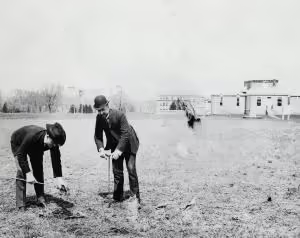
To celebrate National Illinois Day on December 7, USDA’s National Institute of Food and Agriculture highlighted the innovative NIFA-funded research conducted by the University of Illinois Agricultural Experiment Station.
In the following interview with Alex Winter-Nelson, acting associate dean of research and acting director of the Agricultural Experiment Station at University of Illinois, learn more about the state’s history and the agriculture challenges Illinois Agricultural Experiment Station researchers are working to combat.
What are some of your agricultural experiments station’s most notable successes and innovations?
The Morrow Plots are the oldest continually used experimental agricultural fields in the Western Hemisphere and represent the first soil experimental plots in the United States. Founded in 1876 and cultivated each year since then, the plots have provided invaluable data on the effects of crop rotation, natural soil-nutrient depletion and various fertilizers and supplements on soil quality.
Researchers supported by the Illinois Agricultural Experiment Station and the College of Agricultural, Consumer and Environmental Sciences (ACES) have been leaders in livestock nutrition, demonstrating the essential role of amino acids (components of protein) for growth and health of mammals and birds. This work contributed to establishment of modern practices for formulating diets for livestock and poultry based on amino acids, vitamins and minerals.
Other notable successes include pioneering work on no-till farming systems that contributed significantly to reduced soil erosion in the Corn Belt. In addition, Illinois researchers conducted the longest continuous genetics experiment in higher plants, developing highly variable maize populations over 100 cycles of selection. These genetic resources have been refined to create many of today’s elite hybrids.
How does the NIFA-funded research conducted by your institution serve the citizens of your state?
NIFA-supported research in the College of ACES helps make the food and agricultural system of Illinois more sustainable and productive for farmers, processors, and consumers. But our research goes well beyond production agriculture. Our experts use NIFA funds to maintain biodiversity and ecosystems; household and community wellness; and human health and nutrition. For example, the Strong Kids research program engages with Illinois families to learn how a child’s environment and biology work together to contribute to childhood obesity and other health risks.
What are some of the unique agricultural challenges of your state that you are working to address?
Illinois agriculture faces the challenge to be increasingly productive while avoiding negative environmental effects and adapting to a changing climate. Through research, investment and adoption of new practices, the agricultural sector is working to reduce nutrient (e.g., nitrogen) flows into waterways and the atmosphere; increase carbon capture and develop carbon markets; and maintain farm viability in the face of increasing costs and weather uncertainty.
In contrast to many states with large farm sectors, Illinois benefits from a major metropolitan center, Chicago, as well as vibrant agricultural services and food processing industries. As a result, food and agricultural research in Illinois addresses the needs of urban consumers for access to healthy, affordable diets as well as needs of farm producers and agriculture-related industries.
Going forward, how do you see your NIFA-funded search addressing your state’s most pressing issues?
TUniversity of Illinois and the College of ACES will use NIFA support to leverage computational science to enhance food systems through research in digital agriculture. The Center for Digital Agriculture at Illinois is already helping us better understand and manage carbon and nutrient flows, input use and water demand. Our researchers are also applying machine learning and computational capacity to enhance the food security of consumers and the security of our food system with NIFA support. Meaningful work in digital agriculture has begun through projects like Farm of the Future, in which under-canopy autonomous robots improve precision farming through planting, weeding and plant health diagnostics while artificial intelligence-enabled remote sensing provides animal health and development tracking and predictions. Meanwhile, work in our Agroecosystem Sustainability Center is using machine learning and remote sensing to track carbon flows through satellite imagery. With NIFA support, innovations emerging from digital agriculture will help meet the challenges of building a vibrant, sustainable and just food system for the 21st Century in Illinois.
Reshared with permission from NIFA and Rachel Dotson, Public Affairs Specialist. Read the original article.
